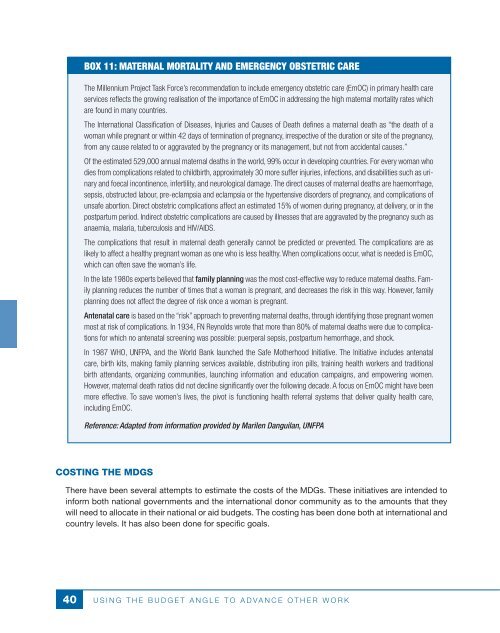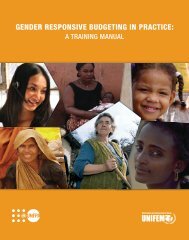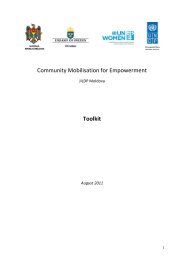Gender Responsive Budgeting and Women's Reproductive Rights ...
Gender Responsive Budgeting and Women's Reproductive Rights ...
Gender Responsive Budgeting and Women's Reproductive Rights ...
You also want an ePaper? Increase the reach of your titles
YUMPU automatically turns print PDFs into web optimized ePapers that Google loves.
Box 11: Maternal mortality <strong>and</strong> emergency obstetric careThe Millennium Project Task Force’s recommendation to include emergency obstetric care (EmOC) in primary health careservices reflects the growing realisation of the importance of EmOC in addressing the high maternal mortality rates whichare found in many countries.The International Classification of Diseases, Injuries <strong>and</strong> Causes of Death defines a maternal death as “the death of awoman while pregnant or within 42 days of termination of pregnancy, irrespective of the duration or site of the pregnancy,from any cause related to or aggravated by the pregnancy or its management, but not from accidental causes.”Of the estimated 529,000 annual maternal deaths in the world, 99% occur in developing countries. For every woman whodies from complications related to childbirth, approximately 30 more suffer injuries, infections, <strong>and</strong> disabilities such as urinary<strong>and</strong> foecal incontinence, infertility, <strong>and</strong> neurological damage. The direct causes of maternal deaths are haemorrhage,sepsis, obstructed labour, pre-eclampsia <strong>and</strong> eclampsia or the hypertensive disorders of pregnancy, <strong>and</strong> complications ofunsafe abortion. Direct obstetric complications affect an estimated 15% of women during pregnancy, at delivery, or in thepostpartum period. Indirect obstetric complications are caused by illnesses that are aggravated by the pregnancy such asanaemia, malaria, tuberculosis <strong>and</strong> HIV/AIDS.The complications that result in maternal death generally cannot be predicted or prevented. The complications are aslikely to affect a healthy pregnant woman as one who is less healthy. When complications occur, what is needed is EmOC,which can often save the woman’s life.In the late 1980s experts believed that family planning was the most cost-effective way to reduce maternal deaths. Familyplanning reduces the number of times that a woman is pregnant, <strong>and</strong> decreases the risk in this way. However, familyplanning does not affect the degree of risk once a woman is pregnant.Antenatal care is based on the “risk” approach to preventing maternal deaths, through identifying those pregnant womenmost at risk of complications. In 1934, FN Reynolds wrote that more than 80% of maternal deaths were due to complicationsfor which no antenatal screening was possible: puerperal sepsis, postpartum hemorrhage, <strong>and</strong> shock.In 1987 WHO, UNFPA, <strong>and</strong> the World Bank launched the Safe Motherhood Initiative. The Initiative includes antenatalcare, birth kits, making family planning services available, distributing iron pills, training health workers <strong>and</strong> traditionalbirth attendants, organizing communities, launching information <strong>and</strong> education campaigns, <strong>and</strong> empowering women.However, maternal death ratios did not decline significantly over the following decade. A focus on EmOC might have beenmore effective. To save women’s lives, the pivot is functioning health referral systems that deliver quality health care,including EmOC.Reference: Adapted from information provided by Marilen Danguilan, UNFPACosting the MDGsThere have been several attempts to estimate the costs of the MDGs. These initiatives are intended toinform both national governments <strong>and</strong> the international donor community as to the amounts that theywill need to allocate in their national or aid budgets. The costing has been done both at international <strong>and</strong>country levels. It has also been done for specific goals.40U s i n g t h e b u d g e t a n g l e t o a d v a n c e o t h e r w o r k





